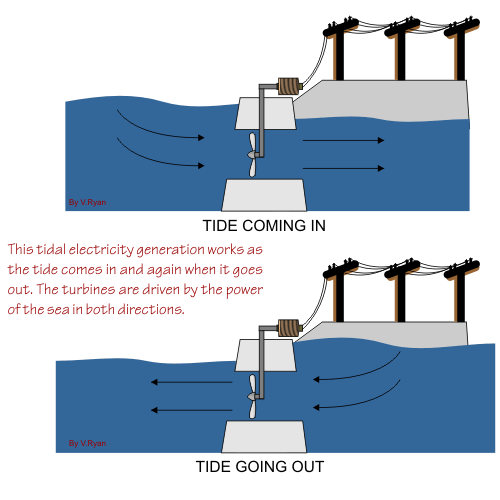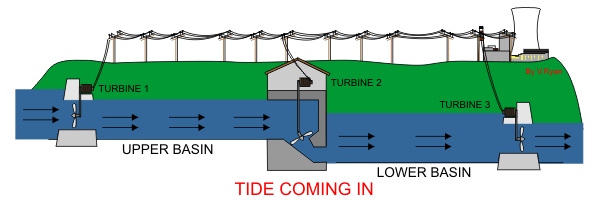Tidal Power
[[URL=“http://2.bp.blogspot.com/_nBaWI2hPVZ4/TRlLkv_s43I/AAAAAAAAA-8/6olGWtxN_yw/s1600/merry-christmas-graphic-animation1.gif”][URL=“http://2.bp.blogspot.com/_nBaWI2hPVZ4/TRlLkv_s43I/AAAAAAAAA-8/6olGWtxN_yw/s1600/merry-christmas-graphic-animation1.gif”]
 .
.Tidal power traditionally involves erecting a dam across the opening to a tidal basin. The dam includes a sluice that is opened to allow the tide to flow into the basin; the sluice is then closed, and as the sea level drops, traditional hydropower technologies can be used to generate electricity from the elevated water in the basin. Some researchers are also trying to extract energy directly from tidal flow streams.
Tidal energy systems can have environmental impacts on tidal basins because of reduced tidal flow and silt buildup.
Ways of Using the Tidal Power of the Ocean
Wave Energy
Kinetic energy (movement) exists in the moving waves of the ocean. T

hat energy can be used to power a turbine. In this simple example, (illustrated to the right) the wave rises into a chamber. The rising water forces the air out of the chamber. The moving air spins a turbine which can turn a generator.
This is only one type of wave-energy system. Others actually use the up and down motion of the wave to power a piston that moves up and down inside a cylinder. That piston can also turn a generator.
Most wave-energy systems are very small. But, they can be used to power a warning buoy or a small light house.
Tidal Energy
[URL=“http://powershift.anetce.com/tidal_dam1.gif”][URL=“http://powershift.anetce.com/tidal_dam1.gif”]

Another form of ocean energy is called tidal energy. When tides comes into the shore, they can be trapped in reservoirs behind dams. Then when the tide drops, the water behind the dam can be let out just like in a regular hydroelectric power plant.
Ocean Thermal Energy
The final ocean energy idea uses temperature differences in the ocean. If you ever went swimming in the ocean and dove deep below the surface, you would have noticed that the water gets colder the deeper you go. It’s warmer on the surface because sunlight warms the water. But below the surface, the ocean gets very cold. That’s why scuba divers wear wet suits when they dive down deep. Their wet suits trapped their body heat to keep them warm.
Power plants can be built that use this difference in temperature to make energy. A difference of at least 38 degrees Fahrenheit is needed between the warmer surface water and the colder deep ocean water.
and in Hawaii in some demonstration projects
Tidal power plant
gate
substation
The devices (such as transformers and changeover switches) that increase the voltage of the electricity and carry it to the network.
basin
inactive dike
administrative building
lock
[URL=“http://visual.merriam-webster.com/images/energy/hydroelectricity/tidal-power-plant/tidal-power-plant.jpg”]
 ](http://2.bp.blogspot.com/_nBaWI2hPVZ4/TRlLkv_s43I/AAAAAAAAA-8/6olGWtxN_yw/s1600/merry-christmas-graphic-animation1.gif)
](http://2.bp.blogspot.com/_nBaWI2hPVZ4/TRlLkv_s43I/AAAAAAAAA-8/6olGWtxN_yw/s1600/merry-christmas-graphic-animation1.gif)



